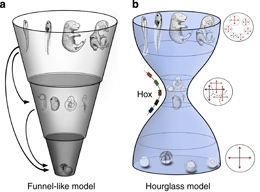Research Abstract
脊椎動物ファイロティピック段階は器官形成期に生じることが比較トランスクリプトーム解析により判明
数種のモデル脊椎動物の胚におけるトランスクリプトームの定量的比較解析を行い、咽頭胚期が最もよく保存されている一方で、初期胚や後期胚は進化的多様性が高いことを明らかにした。
Comparative transcriptome analysis reveals vertebrate phylotypic period during organogenesis
2011年3月22日 Nature Communications 2 : 248 doi: 10.1038/ncomms1248

進化発生生物学における重要な問題の1つは、進化と個体発生をどのようにして定式化するかというものである。主なモデルとしては以下の2つが提唱されてい る。「漏斗型」モデルは、初期胚が進化的に最もよく保存された形態学的パターンを示し、その後に多様化する段階が続くというものだが、もう1つの「砂時 計」モデルの方は、器官形成期が拘束されているために進化的に最も保存されると考えられており、この胚段階はファイロティピック段階と呼ばれている。今回 我々は、数種のモデル脊椎動物の胚におけるトランスクリプトームの定量的比較解析を行い、咽頭胚期が最もよく保存されている一方で、初期胚や後期胚は進化 的多様性が高いことを明らかにした。これらの結果は、異なる種間での発生のおおよそのタイムテーブルの対応関係を予測可能にすること、また咽頭胚段階が最 もよく保存された遺伝子発現プロファイルを持ち、脊椎動物の基本ボディープランの源となっている可能性を示している。
- 理化学研究所 発生・再生科学総合研究センター形態進化研究グループ
One of the central issues in evolutionary developmental biology is how we can formulate the relationships between evolutionary and developmental processes. Two major models have been proposed: the ‘funnel-like’ model, in which the earliest embryo shows the most conserved morphological pattern, followed by diversifying later stages, and the ‘hourglass’ model, in which constraints are imposed to conserve organogenesis stages, which is called the phylotypic period. Here we perform a quantitative comparative transcriptome analysis of several model vertebrate embryos and show that the pharyngula stage is most conserved, whereas earlier and later stages are rather divergent. These results allow us to predict approximate developmental timetables between different species, and indicate that pharyngula embryos have the most conserved gene expression profiles, which may be the source of the basic body plan of vertebrates.

